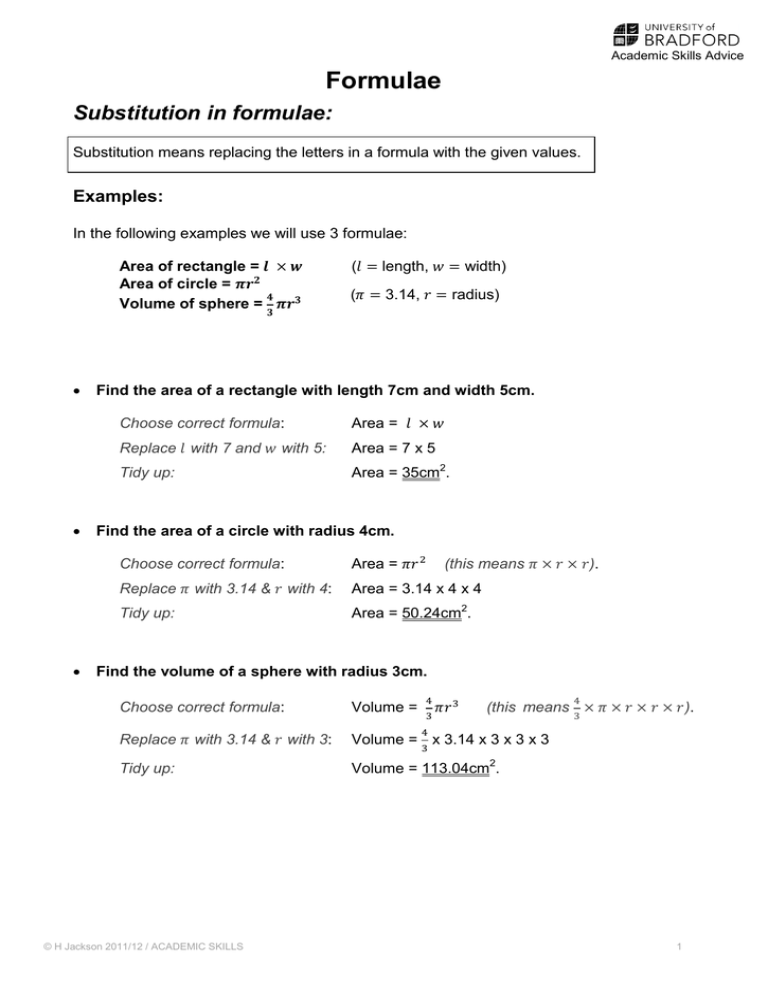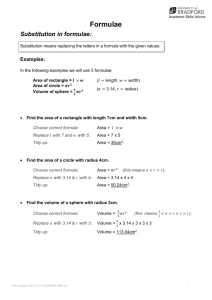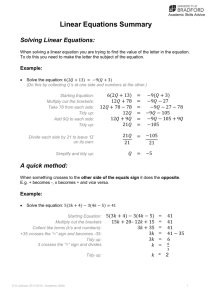Formulae
advertisement

Academic Skills Advice Formulae Substitution in formulae: Substitution means replacing the letters in a formula with the given values. Examples: In the following examples we will use 3 formulae: Area of rectangle = 𝒍 × 𝒘 Area of circle = 𝝅𝒓𝟐 𝟒 Volume of sphere = 𝟑 𝝅𝒓𝟑 (𝑙 = length, 𝑤 = width) (𝜋 = 3.14, 𝑟 = radius) Find the area of a rectangle with length 7cm and width 5cm. Choose correct formula: Area = 𝑙 × 𝑤 Replace 𝑙 with 7 and 𝑤 with 5: Area = 7 x 5 Tidy up: Area = 35cm2. Find the area of a circle with radius 4cm. Choose correct formula: Area = 𝜋𝑟 2 Replace 𝜋 with 3.14 & 𝑟 with 4: Area = 3.14 x 4 x 4 Tidy up: Area = 50.24cm2. (this means 𝜋 × 𝑟 × 𝑟). Find the volume of a sphere with radius 3cm. 4 𝜋𝑟 3 Volume = Replace 𝜋 with 3.14 & 𝑟 with 3: Volume = 3 x 3.14 x 3 x 3 x 3 Tidy up: Volume = 113.04cm2. © H Jackson 2011/12 / ACADEMIC SKILLS 3 4 (this means 3 × 𝜋 × 𝑟 × 𝑟 × 𝑟). Choose correct formula: 4 1 Rearranging formulae: Rearranging (sometimes called transposing) a formula involves ‘reversing’ or ‘undoing’ the formula in order to change the subject. You follow the same rules as for solving equations with one unknown. This is the order for rearranging (reversing): Brackets Add or subtract Multiply or divide Indices (powers) Notice that apart from always doing brackets 1st this is BIDMAS in reverse. Examples: Make 𝒙 the subject of the formula, 𝒚 = 𝒙 − 𝟑. Original formula (𝑦 is the subject): 𝑦 =𝑥−3 Add 3 to each side to leave 𝑥 on its own: 𝑦+3=𝑥 We can rewrite the formula with 𝑥 on the left: 𝑥 =𝑦+3 Notice that −3 + 3 has disappeared. Make ‘𝒂’ the subject of the formula, 𝒗 = 𝒖 + 𝒂𝒕. Original formula (𝑣 is the subject): 𝑣 = 𝑢 + 𝑎𝑡 Subtract ‘𝑢’ from each side: 𝑣 − 𝑢 = 𝑎𝑡 𝑣−𝑢 Divide each side by ‘𝑡’ to leave ‘𝑎’ on its own: =𝑎 𝑡 We can re-write the formula with ‘𝑎’ on the LHS: 𝑎= 𝑣−𝑢 𝑡 The Quick Method This is also similar to solving equations with one unknown - you can think that when something moves to the other side of the equals sign it does the “opposite”. E.g. + becomes -, x becomes ÷ and vice versa. Example: Make 𝒓 the subject of the formula, 𝑨 = 𝝅𝒓𝟐. Original formula (𝐴 is the subject): π is multiplying on the RHS so it crosses the “=” sign and divides: r is being squared on the RHS so the square crosses the “=” sign 𝐴 = 𝜋𝑟 2 𝐴 = 𝑟2 𝜋 and becomes square root: √ =𝑟 𝜋 We can re-write the formula with ‘𝑟’ on the LHS: 𝑟 = √𝜋 © H Jackson 2011/12 / ACADEMIC SKILLS 𝐴 𝐴 2 The Equations of Motion The equations of motion are formulae which link time, distance, velocity and acceleration. They are used a lot in Mechanics & Engineering and are good practice for using formulae. The equations are: 𝑣 = 𝑢 + 𝑎𝑡 1 𝑠 = 2 (𝑢 + 𝑣)𝑡 1 𝑠 = 𝑢𝑡 + 2 𝑎𝑡 2 𝑣 2 = 𝑢2 + 2𝑎𝑠 (𝑢 = 𝑖𝑛𝑖𝑡𝑖𝑎𝑙 𝑣𝑒𝑙𝑜𝑐𝑖𝑡𝑦, 𝑣 = 𝑓𝑖𝑛𝑎𝑙 𝑣𝑒𝑙𝑜𝑐𝑖𝑡𝑦, 𝑠 = 𝑑𝑖𝑠𝑡𝑎𝑛𝑐𝑒, 𝑎 = 𝑎𝑐𝑐𝑒𝑙𝑒𝑟𝑎𝑡𝑖𝑜𝑛, 𝑡 = 𝑡𝑖𝑚𝑒) 2 (velocity in metres per second, distance in metres, acceleration in metres per second and time in seconds). When solving a question using the equations of motion it’s a good idea to start by writing down: s= u= v= t= a= Then fill in everything you know from the question (and what you are trying to find). This should help you to decide which equation to use. Examples: Find the distance travelled after 10 seconds if the initial velocity was 0 and the acceleration is 9.8. Think about what the question has given us: s=? u=0 v = not needed t = 10 a = 9.8 We need to look for the formula that includes s, u, t & a. 1 Choose correct formula: s = 𝑢𝑡 + 2 𝑎𝑡 2 Replace each letter with its number: s = (0)(10) + 2 (9.8) × 102 Tidy up: s = 0 + 490 1 Distance © H Jackson 2011/12 / ACADEMIC SKILLS = 490m 3 A runner in a 200m race crosses the finishing line travelling at 12 m/s. What was their acceleration? Think about what the question has given us: s = 200 u=0 v = 12 t = not given a=? We need to look for the formula that includes s, u, v & a. Choose correct formula: 𝑣 2 = 𝑢2 + 2𝑎𝑠 Replace each letter with its number: 122 = 02 + 2𝑎(200) Tidy up: 144 = 400𝑎 Rearrange to find 𝑎: 𝑎 = 400 144 Acceleration = 0.36m/s2 A racing car starts from rest and accelerates at 13.8m/s2. The car continues to accelerate until it reaches a velocity of 78m/s. How long did the car travel before reaching this velocity? Think about what the question has given us: s = not given u=0 v = 78 t=? a = 13.8 We need to look for the formula that includes u, v, t & a. Choose correct formula: 𝑣 = 𝑢 + 𝑎𝑡 Replace each letter with its number: 78 = 0 + 13.8𝑡 Tidy up: 78 = 13.8𝑡 Rearrange to find 𝑡: 𝑡 = 13.8 78 Time = 5.7 seconds © H Jackson 2011/12 / ACADEMIC SKILLS 4



